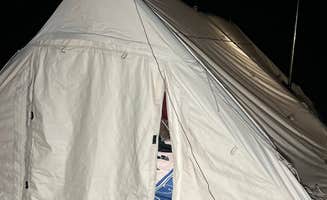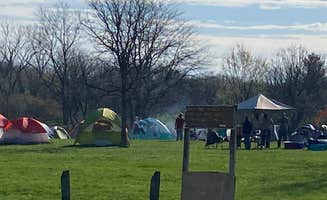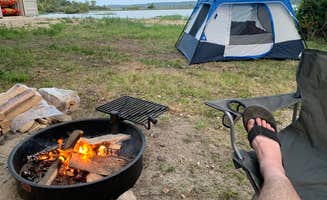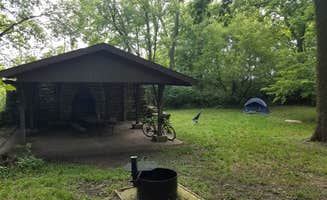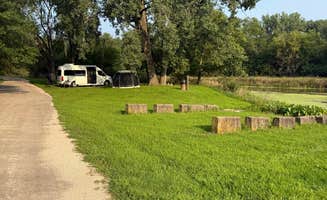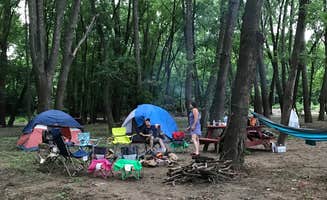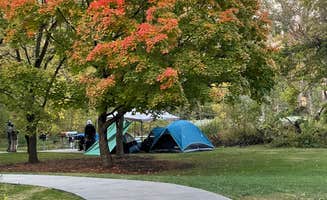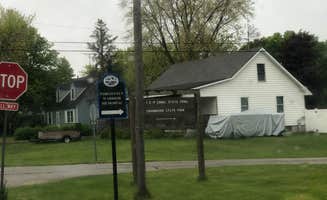Tent camping options around Peru, Illinois concentrate along the Illinois River valley, typically at elevations ranging from 450-650 feet above sea level. The region experiences humid continental climate with four distinct seasons, making spring and fall the most comfortable for camping. Most primitive sites in the region sit on level terrain with a mix of open grassland and wooded borders, creating diverse microclimates within single campgrounds.
What to do
Kayaking and canoeing: Kayak Morris provides direct water access for paddling adventures. "Between me and my buddies we caught over 50 striper. I don't know if its the river convergence or the lake but they bite here hard!" according to camper Sam Murphy M. Many campers appreciate the easy river access, noting "we brought our own kayaks and launched right from our campsite."
Hiking historic trails: The I&M Canal Tow Path connects multiple camping areas and provides walking routes with historical significance. At Buffalo Rock State Park Campground, a camper mentioned "Walk to Ottawa is very magical," highlighting how trail connections create longer hiking opportunities beyond individual parks.
Wildlife observation: Several conservation areas host native Illinois wildlife. One camper at Buffalo Rock noted "Real live Buffalo are a treat for kids and animal lovers." Viewing platforms and designated wildlife areas exist throughout the region's parks, with several campers reporting owl sightings and fish activity during evening hours.
Winter recreation: When snow falls, many of the camping areas transform for cold-weather activities. Trails at several parks convert to cross-country ski routes, with Castle Rock State Park Campground offering "great cross-country skiing and tobogganing" during winter months according to visitor documentation.
What campers like
Seclusion on boat-in sites: River access creates unique camping opportunities with exceptional privacy. At Castle Rock State Park Campground, Jessica W. discovered incredible solitude: "I had the entire campground to myself, with the exception of my husband, friend, and dog friend. The reason this campground is so empty is because it can not be accessed by car."
Clean facilities despite primitive settings: Many campers express surprise at maintenance levels. "The Porta potties were shockingly clean! The potties also have motion sensor lights in them for at night visits. They also have wipes, spray underarm deodorant, hand sanitizer and automatic air freshener," noted Paul R. at Kayak Starved Rock Campground.
Budget-friendly camping: Most primitive sites maintain low rates compared to developed campgrounds. At Hennepin Canal Lock 21 Campground, a visitor mentioned "Only $8" for overnight camping with basic amenities, while another noted Illinois residents over 62 camp free Sunday through Thursday.
Stargazing opportunities: The rural setting creates excellent night sky viewing. Several campers specifically mentioned star visibility, with one at Castle Rock noting they observed "tons of glow worms hanging out in a small creek that runs into the river" alongside "spectacular view of the starry sky at night."
What you should know
River conditions change seasonally: Water levels affect campsite accessibility and paddling difficulty. One Castle Rock camper warned: "It was tough paddling upstream when I returned to the boat launch after camping, even after a dry spell." Plan accordingly for return journeys when boating to remote sites.
First-come, first-served policies: Many conservation areas don't accept reservations. A camper at Hennepin Canal Lock 11 explained: "Camping at the Canal is on a first-come, first-serve basis. There are no set check-in or check-out times. The Canal's site security officer makes rounds to each campsite to collect camping fees, in-person."
Limited drinking water: Most primitive sites lack potable water sources. Multiple campers note bringing their own water is essential. One camper at Hennepin Canal advised: "There are no operable drinking water fountains along the canal so bring your own water for your hike or camping trip."
Variable site privacy: Campsite spacing varies dramatically between locations. At Kayak Starved Rock Campground, Cullen S. observed: "The biggest thing we disliked about this place is how close the campsites are to one another. With a tent at every site, you're almost right on top of the next site, enough to clearly hear the person snoring two tents over."
Tips for camping with families
Consider youth group options: For organized groups, dedicated facilities provide specialized camping. Starved Rock State Park - Youth Campground features "two wide-open meadows encircled by thick treelines providing a number of choices as to where you want to pitch your tent for the night," according to Stuart K., who adds there are "dueling outhouses, one for the lads and another for the lasses."
Insect preparedness: Seasonal bug activity varies by location. One Buffalo Rock camper mentioned encountering "bunches of large gnat-like insects but they didn't bite like mosquitos," while a Castle Rock camper noted seeing "a billion harmless tiny white moths by the river."
Access to playgrounds: Some campgrounds include play facilities for children. At Castle Rock, a camper mentioned that "The park has a playground, restroom (with running water), and drinking fountains with spouts" making it more suitable for families with younger children.
Fishing opportunities: Multiple locations offer fishing access for all ages. At Kayak Morris, campers report excellent fishing success, with one noting "we caught over 50 striper" during their stay, making this activity particularly appealing for family camping trips.
Tips from RVers
Limited hookup options: Most camping in the Peru area prioritizes tent camping with minimal RV amenities. Jeff and Linda L. reported at Hennepin Canal Lock 21: "No hook-ups, just grass with a fire pit and table. Water available a couple of places along the canal," though they did note "We saw a class A, so they do fit."
Road condition warnings: Access roads to some campgrounds present challenges for larger vehicles. At Clark's Run Campground, Stuart K. warned: "This CG sits on the bend on 178... This place could really use some simple landscaping and TLC to make the place much more appealing," noting "the signs marking this place are low and small."
Alternative parking strategies: Some areas allow RV parking while campers explore by other means. At Castle Rock, visitors mentioned "we parked at the Castle Rock State Park boat launch site, where overnight parking is permitted" then paddled to tent sites, creating a hybrid RV/tent camping approach suitable for those with watercraft.


